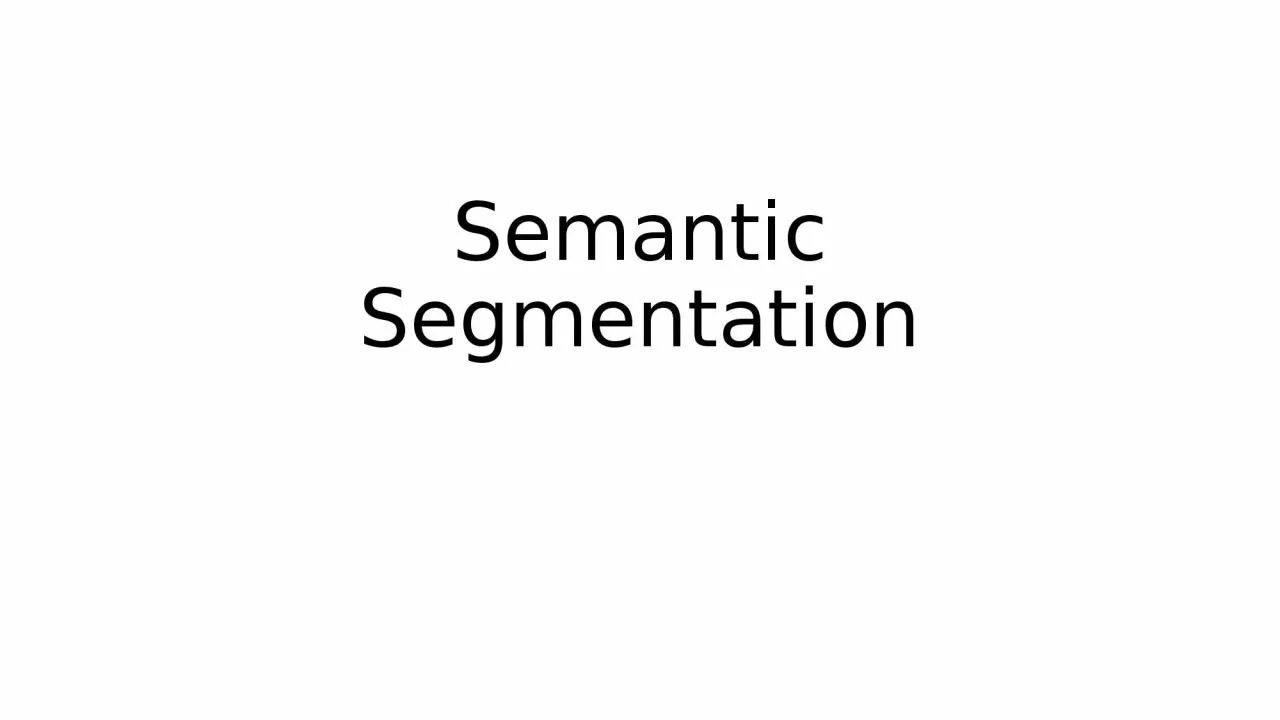

person grass trees motorbike road Evaluation metric Pixel classification Accuracy Heavily unbalanced Common classes are overemphasized Intersection over Union Average across classes and images ID: 921243
Download Presentation The PPT/PDF document "Semantic Segmentation The Task" is the property of its rightful owner. Permission is granted to download and print the materials on this web site for personal, non-commercial use only, and to display it on your personal computer provided you do not modify the materials and that you retain all copyright notices contained in the materials. By downloading content from our website, you accept the terms of this agreement.
Slide1
Semantic Segmentation
Slide2The Task
person
grass
trees
motorbike
road
Slide3Evaluation metric
Pixel classification!
Accuracy?
Heavily unbalanced
Common classes are over-emphasized
Intersection over UnionAverage across classes and imagesPer-class accuracy
Compute accuracy for every class and then average
Slide4Things vs Stuff
THINGS
Person, cat, horse,
etc
Constrained shape
Individual instances with separate identityMay need to look at objects
STUFFRoad, grass, sky etcAmorphous, no shape
No notion of instancesCan be done at pixel level“texture”
Slide5Challenges in data collection
Precise localization is hard to annotate
Annotating every pixel leads to heavy tails
Common solution: annotate few classes (often things), mark rest as “Other”
Common datasets: PASCAL VOC 2012 (~1500 images, 20 categories), COCO (~100k images, 20 categories)
Slide6Pre-convnet
semantic segmentation
Things
Do object detection, then segment out detected objects
Stuff”Texture classification”
Compute histograms of filter responsesClassify local image patches
Slide7Semantic segmentation using convolutional networks
h
w
3
Slide8Semantic segmentation using convolutional networks
h/4
w/4
c
Slide9Semantic segmentation using convolutional networks
c
h/4
w/4
Slide10Semantic segmentation using convolutional networks
h/4
w/4
c
Can be considered as a feature vector for a pixel
Slide11Semantic segmentation using convolutional networks
c
Convolve with #classes
1x1 filters
#classes
h/4
w/4
Slide12Semantic segmentation using convolutional networks
Pass image through convolution and subsampling layers
Final convolution with #classes outputs
Get scores for
subsampled imageUpsample
back to original size
Slide13Semantic segmentation using convolutional networks
person
bicycle
Slide14The resolution issue
Problem: Need fine details!
Shallower network / earlier layers?
Deeper networks work better: more abstract concepts
Shallower network => Not very semantic!Remove subsampling?
Subsampling allows later layers to capture larger and larger patternsWithout subsampling => Looks at only a small window!
Slide15Solution 1: Image pyramids
Learning Hierarchical Features for Scene Labeling. Clement
Farabet
, Camille
Couprie
, Laurent
Najman
, Yann
LeCun
. In
TPAMI,
2013.
Higher resolution
Less context
Small networks that maintain resolution
Slide16Solution 2: Skip connections
upsample
Compute class scores at multiple layers, then
upsample
and add
Slide17Solution 2: Skip connections
Red arrows indicate backpropagation
Slide18Skip connections
Fully convolutional networks for semantic segmentation. Evan
Shelhamer
, Jon Long, Trevor Darrell. In
CVPR
2015
without skip
with skip
Slide19Skip connections
Problem: early layers not semantic
Horse
Visualizations from : M.
Zeiler
and R. Fergus. Visualizing and Understanding Convolutional Networks. In
ECCV
2014.
Slide20Solution 3: Dilation
Need subsampling to allow convolutional layers to capture large regions with small filters
Can we do this without subsampling?
Slide21Solution 3: Dilation
Need subsampling to allow convolutional layers to capture large regions with small filters
Can we do this without subsampling?
Slide22Solution 3: Dilation
Need subsampling to allow convolutional layers to capture large regions with small filters
Can we do this without subsampling?
Slide23Solution 3: Dilation
Instead of subsampling by factor of 2: dilate by factor of 2
Dilation can be seen as:
Using a much larger filter, but with most entries set to 0
Taking a small filter and “exploding”/ “dilating” it
Not panacea: without subsampling, feature maps are much larger: memory issues
Slide24Putting it all together
Best Non-CNN approach: ~46.4%
Semantic Image Segmentation with Deep Convolutional Nets and Fully Connected CRFs. Liang-
Chieh
Chen, George Papandreou,
Iasonas
Kokkinos, Kevin Murphy, Alan
Yuille
. In
ICLR,
2015.